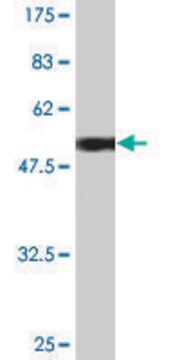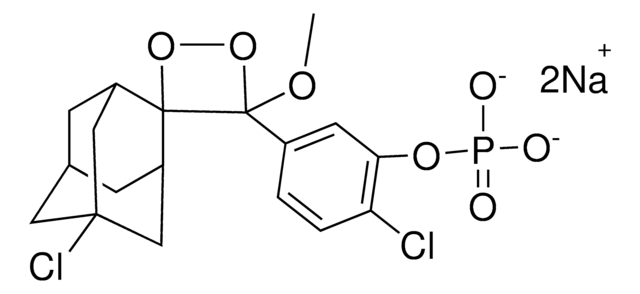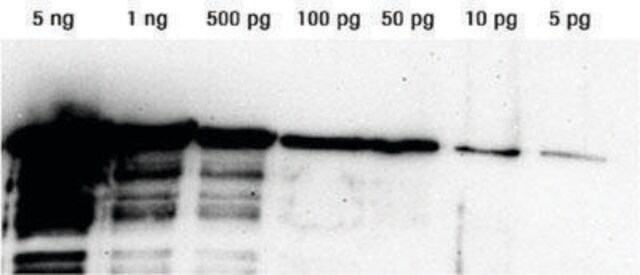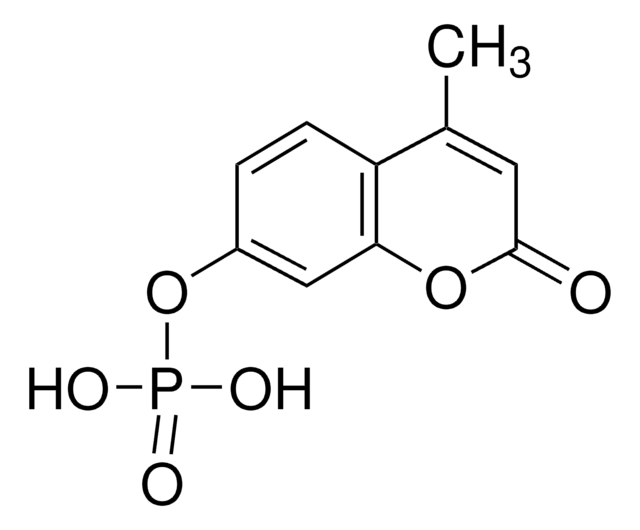11582950001
Roche
BM Chemiluminescence ELISA Substrate (POD)
Sinonimo/i:
ELISA substrate
Autenticatiper visualizzare i prezzi riservati alla tua organizzazione & contrattuali
About This Item
Codice UNSPSC:
12352204
Prodotti consigliati
Stato
solution
Livello qualitativo
Confezionamento
pkg of 250 mL (for 2500 wells or 1000 tubes)
Produttore/marchio commerciale
Roche
Condizioni di stoccaggio
(Keep container tightly closed in a dry and well-ventilated place.)
tecniche
ELISA: suitable
Colore
clear colorless
Solubilità
water: miscible
Compatibilità
suitable for chemiluminescence
Condizioni di spedizione
wet ice
Temperatura di conservazione
2-8°C
Descrizione generale
The sensitivity of enzyme-linked immunosorbent assays often depends on the detection limit of the colorimetric substrates used. In addition, the dynamic range of a colorimetric assay is restricted to a maximum of two orders of magnitude due to the physical/chemical limitations of absorbance measurement (Law of Lambert & Beer). With chemiluminescence technology, a nonradioactive method, which combines the convenience of tube or microplate-based immunoassays with the advantages of isotopic assays, is now available. The BM Chemiluminescence ELISA Substrate (POD) has been evaluated with different immunoassays on the LB 96 P microplate reader and the LB 953 tube chemiluminescence analyzer from EG&G;Berthold.
Applicazioni
The BM Chemiluminescence ELISA Substrate (POD) provides a substrate solution for peroxidase-based (POD, HRP) secondary detection systems with highly sensitive, enhanced chemiluminescence. This reagent has been optimized for ELISA applications to be run on a microplate chemiluminescence reader (96-well format) or tube-format luminometers.
Caratteristiche e vantaggi
- Improved sensitivity
- Large dynamic range
- Rapid and constant signal
Contents
Substrate Reagent A (buffered solution that contains luminol/4-iodophenol)
Starting Reagent B (buffered solution that contains a stabilized form of H2O2)
Principio
Horseradish peroxidase (POD, HRP), in the presence of hydrogen peroxide (H2O2), catalyzes the oxidation of diacylhydrazides such as luminol. A reaction product in an excited state is thus formed, then decays to the ground state by emitting light. Strong enhancement of the light emission is achieved by the agent 4-iodophenol (contained), which acts as a radical transmitter between the formed oxygen radical and luminol.
Nota sulla preparazione
Working solution: Preparation of working solution
The BM Chemiluminescence ELISA Substrate is supplied as a set of two stable solutions. Depending on the scale of the assay, the appropriate amount of substrate solution has to be prepared 15 minutes before use:
Storage conditions (working solution): The premixed solution is stable for 1 week, when stored at 2 to 8 °C.
The BM Chemiluminescence ELISA Substrate is supplied as a set of two stable solutions. Depending on the scale of the assay, the appropriate amount of substrate solution has to be prepared 15 minutes before use:
- Add to 100 parts of solution A one part of solution B.
- Stir the mixture for at least 15 minutes at 15 to 25 °C to equilibrate the components.
Storage conditions (working solution): The premixed solution is stable for 1 week, when stored at 2 to 8 °C.
Altre note
For life science research only. Not for use in diagnostic procedures.
Codice della classe di stoccaggio
12 - Non Combustible Liquids
Classe di pericolosità dell'acqua (WGK)
WGK 1
Punto d’infiammabilità (°F)
does not flash
Punto d’infiammabilità (°C)
does not flash
Scegli una delle versioni più recenti:
Possiedi già questo prodotto?
I documenti relativi ai prodotti acquistati recentemente sono disponibili nell’Archivio dei documenti.
I clienti hanno visto anche
Hayley Dingsdale et al.
Journal of psychiatric research, 150, 47-53 (2022-03-31)
Altered serum levels of brain-derived neurotrophic factor (BDNF) are consistently linked with neurological disorders. BDNF is also increasingly implicated in the pathogenesis of neurodevelopmental disorders, particularly those found more frequently in males. At birth, male infants naturally have significantly lower
Adam Zwolak et al.
Scientific reports, 12(1), 20538-20538 (2022-11-30)
TL1A (TNFSF15) is a TNF superfamily ligand which can bind the TNFRSF member death receptor 3 (DR3) on T cells and the soluble decoy receptor DcR3. Engagement of DR3 on CD4+ or CD8+ effector T cells by TL1A induces downstream signaling, leading
Stefania Kalogera et al.
Scientific reports, 11(1), 24285-24285 (2021-12-22)
Osteoarthritis (OA) and rheumatoid arthritis (RA) are serious and painful diseases. Protease-activated receptor 2 (PAR2) is involved in the pathology of both OA and RA including roles in synovial hyperplasia, cartilage destruction, osteophyogenesis and pain. PAR2 is activated via cleavage
F Gagné et al.
Comparative biochemistry and physiology. Toxicology & pharmacology : CBP, 153(1), 99-106 (2010-09-28)
The endocrine-disrupting activity of municipal effluents has the potential to alter the reproductive system and induce feminization to aquatic organisms. The purpose of this study was to examine the sex ratio, vitellogenin (Vtg)-like proteins, serotonin, arachidonate cyclooxygenase (COX) activity and
Suvoshree Ghosh et al.
Human mutation, 43(1), 42-55 (2021-11-25)
γ-Glutamyl carboxylase (GGCX) catalyzes the γ-carboxylation of 15 different vitamin K dependent (VKD) proteins. Pathogenic variants in GGCX cause a rare hereditary bleeding disorder called Vitamin K dependent coagulation factor deficiency type 1 (VKCFD1). In addition to bleedings, some VKCFD1
Il team dei nostri ricercatori vanta grande esperienza in tutte le aree della ricerca quali Life Science, scienza dei materiali, sintesi chimica, cromatografia, discipline analitiche, ecc..
Contatta l'Assistenza Tecnica.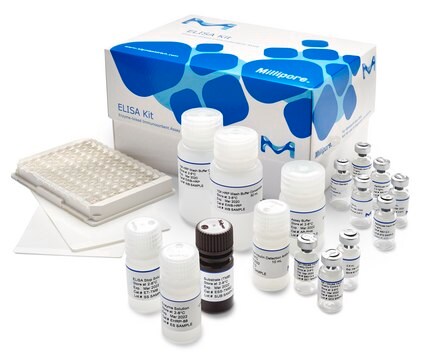

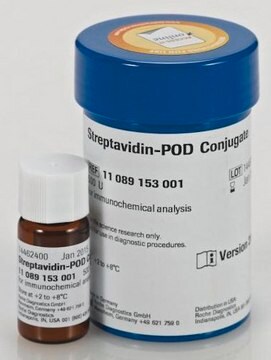
![BM Chemiluminescence Western Blotting Substrate (POD) pkg of 1 set (11500708001 [1,000 cm2 membrane]), pkg of 1 set (11500694001 [4,000 cm2 membrane])](/deepweb/assets/sigmaaldrich/product/images/352/091/ef743cea-ccd8-44f1-8f3b-dec5a1e4f5d1/640/ef743cea-ccd8-44f1-8f3b-dec5a1e4f5d1.jpg)
